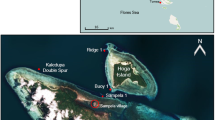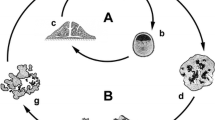Abstract
We studied the life cycle and growth of Spongilla lacustris in a stream with three distinct habitats. Sponge populations in the habitats exhibited different adaptive strategies. Growth forms of S. lacustris ranged from encrusting to digitate and branched. Environmental factors controlled the appearance of each growth form. In the most hospitable habitat, a variety of colonization strategies and different growth forms were present. In the less hospitable habitat growth was restricted to small and encrusting specimens. In the optimal habitat, the largest and most luxuriant specimens developed. Gemmulation and hatching were dephased among specimens in the three habitats; hence gemmules were present for long periods of time. S. lacustris was found capable of displaying two life strategies: r in the short run, K in the long run.
Similar content being viewed by others
References
Berg, K., 1948. Biological studies on the River Susaa. Faunistic and biological investigations, Porifera. Folia limnol. scand. 4: 10–23.
Frost, T. M., G. S. De Nagy & J. J. Gilbert, 1982. Population dynamics and standing biomass of the freshwater sponge Spongilla lacustris. Ecology 63: 1203–1210.
Frost, T. M. & C. E. Williamson, 1980. In situ determination of the effect of symbiotic algae on the growth of the freshwater sponge Spongilla lacustris. Ecology 61: 1361–1370.
Jewell, M. E., 1935. An ecological study of the fresh-water sponges of northern Wisconsin. Ecol. Monogr. 5: 461–504.
Mayr, E., 1963. Animal species and evolution. Harvard Univ. Press, Cambridge: 865 pp.
Old, M. C., 1932. Environmental selection of the fresh-water sponge (Spongillidae) of Michigan. Trans. am. microsc. Soc. 51: 129–136.
Pronzato R. & R. Manconi, in press. Colonization, life cycle and competition in a fresh water sponge association. In H. Keupp & J. Reitner (eds), Fossil and Recent Sponges, Springer, Berlin.
Rader, R. B., 1984. Factors affecting the distribution of a freshwater sponge. Freshwat. Invert. Biol. 3: 86–97.
Sarà, M. & J. Vacelet, 1973. Ecologie des Démosponges. In P. P. Grassè (Ed.) Traité de Zoologie, Anatomie, Systematique, Biologie, Masson et Cie, Paris: 462–564.
Stearns, S. C., 1982. The rôle of development in the evolution of life histories. In J. T. Bonner (ed.) Evolution and Development, Springer, Berlin: 237–258.
Author information
Authors and Affiliations
Rights and permissions
About this article
Cite this article
Manconi, R., Pronzato, R. Life cycle of Spongilla lacustris (Porifera, Spongillidae): a cue for environment-dependent phenotype. Hydrobiologia 220, 155–160 (1991). https://doi.org/10.1007/BF00006548
Received:
Revised:
Accepted:
Issue Date:
DOI: https://doi.org/10.1007/BF00006548




